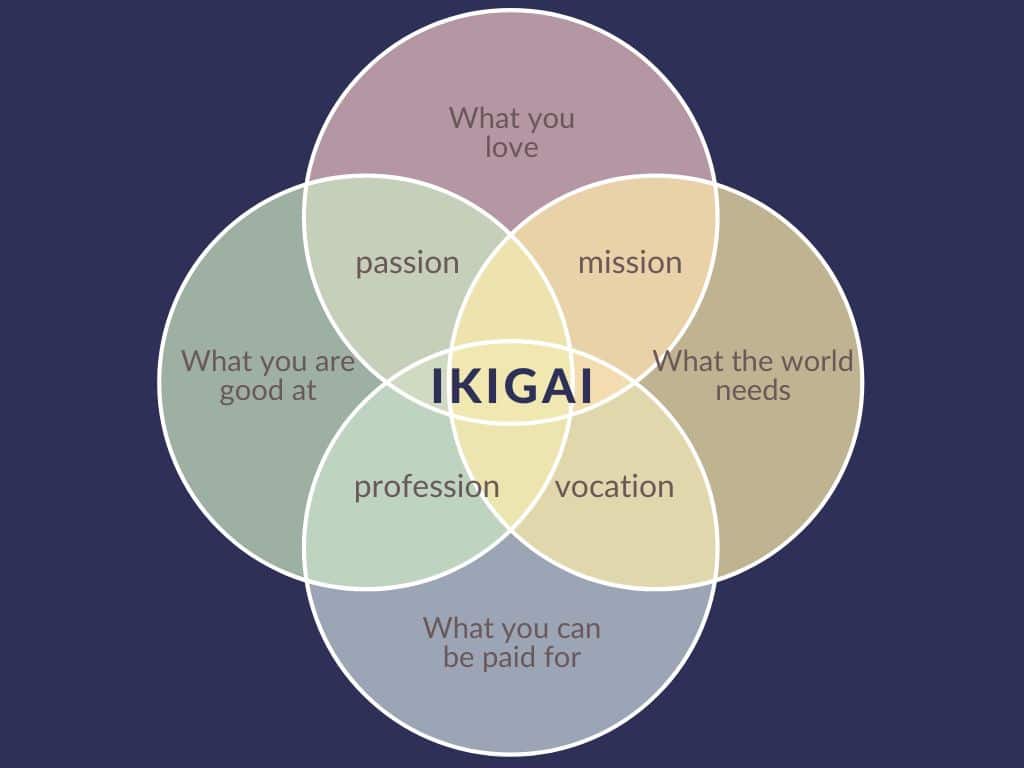What do you wake up for in the morning? Are you proud of your job? Does it give you purpose?
This article will explore the concept of Ikigai, its meaning, its purpose and how you can adopt this concept for yourself or into your wider business to improve decision-making, morale, mental health, productivity and motivation.
Key Points:
- Ikigai (pronounced ee-key-guy) is a Japanese theory dating back 3000 years; it translates to ‘reason for being’ or ‘reason for living’.
- It’s a philosophy to help you find clarity in various aspects of your life in order to improve your mental health and contentment.
- It can have benefits in the workplace, such as increased productivity, wellbeing and motivation.
What is ikigai?
Ikigai means having a sense of purpose and direction, which can help you figure out what you value in life and increase your satisfaction. This clarity can help you make good decisions, be more open and feel happier, which will positively impact your colleagues and increase productivity.
It was popularised by Héctor García and Francesc Miralles’ well-known book Ikigai – the Japanese Secret to a Long and Happy Life .
💡Expert-insight💡
“Ikigai can help you ‘find your why’ – your personal motivation. Sharing your motivation with others is a big part of building trustworthiness in leadership.” – Leadership and management expert, Andrew Wallbridge.
How do you adopt Ikigai into your personal and professional life?
Ikigai is a way for us to consider your personal values and those of the company you work for, and convert your purpose into actions that can benefit yourself and your workplace.
To do this, Ikigai is broken down into four components and five pillars.
The four components of ikigai
The four components of ikigai are:
#1. What you love or care about
Think about what kind of tasks you enjoy – do you like physical labour, technical work, or would you prefer to present, organise or coordinate? Also consider whether you like to work with people or independently.
Perhaps problem solving is a fun challenge for you or you enjoy expressing your creativity. Finding what you care about can be a strong motivator when it comes to success.
#2. What you’re good at
Most of what we’re good at are things we do regularly, but you might have stumbled upon a particular talent completely out of the blue. For example, are you a whizz at understanding complex theories or rules? Are you particularly dexterous or agile? You could be good at interacting with people or have a good grasp of a particular subject, like maths or foreign languages.
If you can get into a good flow with your talent, you can find joy in that and even share it with others.
#3. What the world needs
Learning what the world needs doesn’t necessarily mean quitting your job and retraining as a teacher or doctor – you don’t need to save the world to contribute to it. It’s simply a case of understanding how you can put others before yourself.
This can be something like offering to help a colleague with a task or organising a team volunteering day at a local charity. Even something as simple as being kind can make your workplace better for everyone.
#4. What you can be paid for
This might be the trickiest component of all, but it’s not impossible to find something you’re good at and care about, that you can be paid to do. For example, if you love helping people and are good at problem solving, you could ask to take on more customer-facing tasks. Or maybe if you like keeping things organised and are good at interacting with people, you could ask to lead a project.
These four components are about the small ways you can bring together what you’re good at and what you enjoy doing, with what the world needs and will pay for. If you can combine all of these, your employees will find their ikigai and be healthier, happier and more productive.
The five pillars of ikigai
With these five pillars, you can evaluate how the four components of ikigai relate to you. The five pillars of ikigai are:
#1. Starting small
Being especially careful with the details can lead to greater achievements. Starting small means thinking more about the process that leads to the end goal.
💡Example💡
Carefully planning a workshop with care and attention can lead to a better experience and outcome, and make it more enjoyable.
#2. Releasing yourself
Knowing and accepting who you are and how you feel (otherwise called ‘ self-awareness ’) is a key part of being a good leader and generally feeling content. Everyone is unique and nobody is perfect. So instead of comparing yourself to others, accepting how you are as an individual and then developing and learning through experiences and training can give you and your staff a better awareness and improved emotional intelligence.
#3. Harmony and sustainability
This is all about being mindful of how your actions and emotions affect other people – this is called self-regulation . When interacting with others, consider what impact you may have on them.
💡Example💡
When you’re called upon in a meeting, don’t feel pressured to have a quick response ready – it’s better to take a pause to consider what you’ll say and the outcome this might have. Or if you’re in a group discussion, make sure everybody has the opportunity to speak freely.
It’s important for leaders to find harmony in the conversation and to give everyone an equal voice to help strengthen relationships and improve communication.
#4. The joy of little things
Small, rewarding experiences in the workplace can boost morale and productivity. This can be an experience you as a leader provide – such as praise or recognition for a good job – or something an employee finds themselves, like having a sweet treat at lunch. It doesn’t have to be the same thing for everyone, as long as it’s significant to each individual.
#5. Being in the here and now
You can’t fully enjoy something if you’re not present and in the moment. It’s common to be fixated on the outcome and how we will feel then. Instead it’s important to focus on how we feel now, and as mentioned above, find joy in the small things instead.
💡Example💡
Instead of focussing on the outcome of a project, think about the actions you’re taking right now – how do you feel? Are you getting the support you need? Is there anything you can do to bring joy to yourself and others?
Who can use ikigai?
Everyone in an organisation can benefit from ikigai. For leaders, it can help with self-reflection and finding a sense of purpose in the workplace, as well as helping you better engage with people across the organisation.
Individuals can also benefit from this as it gives them a greater sense of purpose and can teach them how to love their job. It’s important to remember that ikigai isn’t just about becoming a happier and more productive worker, but also finding opportunities in everyday activities to fulfil your values and explore your passions.
How can leaders use ikigai to benefit the workplace?
Passing on a sense of purpose and reason for being in the workplace to your team can increase employees’ sense of worth, boost morale, improve motivation and wellbeing.
For example, you could implement ikigai philosophies into your role as a leader by having discussions around what your colleagues enjoy, what they’re good at and whether you can help them get clarity on their importance to the company or the team. This could be great for a 1-2-1 chat, or perhaps as a group activity or icebreaker.
Helping your team get into a good flow can also be a beneficial way to use ikigai.
💡Three tips to help you find your flow💡
- Set aside time to focus on one thing: for example, blocking out time for lunch or to work on a particular project
- Start the day with something you enjoy: this can be something as simple as listening to your favourite song, or doing something creative like painting or writing
- Remove unnecessary distractions: some people find it hard to concentrate with lots of background noise, but others will find this helps. Do what feels right for you so you can relax and focus on being present for your task
Simply by implementing ikigai yourself and having open conversations with your team about it can help your employees expand their thinking which will benefit themselves and your workplace.
What are the benefits of ikigai?
One benefit of ikigai is better mental health. For example, finding something you enjoy, that you’re good at and that helps others can boost your confidence and be a good motivator. Also if you’re paid for it, this can alleviate any money worries and reduce stress.
Other benefits of ikigai are being able to see things clearly and being more self-aware. If you’re able to focus on the moment and have a greater awareness of your own and other people’s thoughts, feelings and actions then you’ll be able to better adapt and improve relationships with your team.
Practising ikigai is generally a great way to help develop your social skills as it helps you consider other perspectives and encourages mindfulness.








